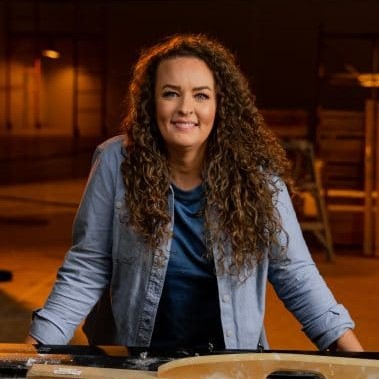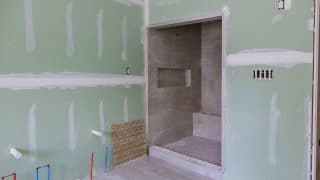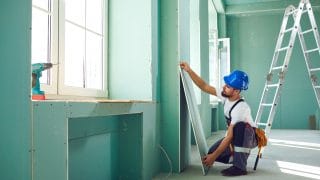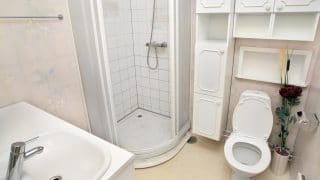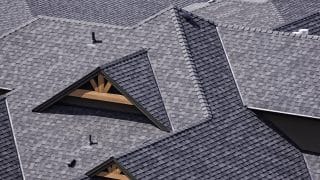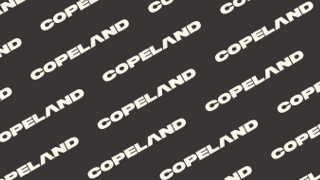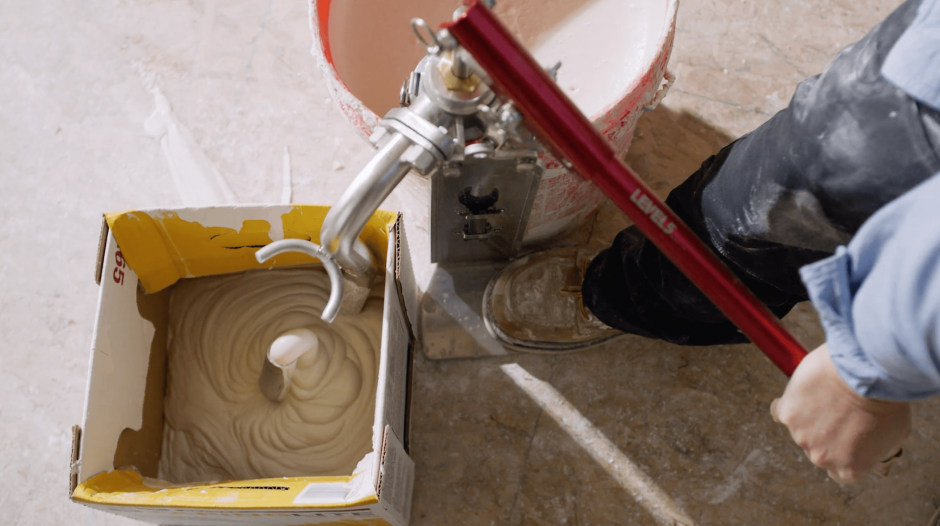
Mudding is a key component to working with drywall (also known as Sheetrock); it helps create smooth, seamless walls. Because drywall is installed in sheets and pieces, mudding is necessary to fill in the gaps and even out the surface.
What is mudding?
Drywall mud is a joint compound—a gypsum-based paste that performs several functions in the drywall-finishing process: It’s the glue that holds drywall together, patching over any screws, seams, or joints; it binds drywall tape and drywall board; and it helps prepare drywall surfaces for paint. Mudding—the process of applying joint compound—is something you’ll do many times when installing drywall.
Mudding serves an aesthetic purpose as well as a structural one: It provides structural support and smoothes walls so there are no signs of creases or joints. Because drywall is installed in sheets, mudding creates the look of one wall or ceiling.
Types of drywall mud
There are several different types of drywall muds you can use throughout the process.
Premixed
As its name suggests, these muds come premixed with water. They’re ready to use out of the box and don’t dry quickly. Sometimes, depending on the weather, premixed mud can take several days to completely dry, causing delays. Premixed muds are ideal for taping, use with automatic tools like boxes and automatic tapers, and coating. The most common premixed muds you’ll find are all-purpose, lightweight all-purpose, and topping muds.
Powdered (hot mud)
Powdered mud, also known as hot mud, needs to be mixed with water for application. Once the hot mud is mixed, there’s a limited time to work with it since it’s a quick-setting mud. (It usually takes about 20 to 60 minutes to dry, depending on the mud’s additives.) Hot mud is ideal for coating and pre-filling joints on drywall since it expands as it dries, filling gaps.
Mudding tools
There are many different tools you can use for drywall mudding. The ones you select will depend on your level of expertise, the type of mud you’ve chosen, and their purpose, be it taping, coating, or pre-filling.
Hawk
Hawks are flat, square pieces of metal that hold mud. Commonly used with a trowel, a tool that spreads mud, hawks can also be used with a mudding knife. Hawks can carry large amounts of mud if you’re coating the entire surface of the drywall, but aren’t ideal for thinner muds since they can slide off the surface. Hawks are best for thicker muds, as when pre-filling joints.
Trowel
These handheld mudding tools with flat, thin metal sheets spread a large amount of mud across the surface. They leave a nice smooth finish and are ideal for texturing and coating. Trowels can move a lot of mud and be used to feather edges or remove excess mud that makes the drywall uneven. Trowels are most commonly used for plasterwork, which requires spreading lots of mud over large surfaces and an ultra-smooth finish.
Mudding is a key component to working with drywall (also known as Sheetrock); it helps create smooth, seamless walls. Because drywall is installed in sheets and pieces, mudding is necessary to fill in the gaps and even out the surface.
What is mudding?
Drywall mud is a joint compound—a gypsum-based paste that performs several functions in the drywall-finishing process: It’s the glue that holds drywall together, patching over any screws, seams, or joints; it binds drywall tape and drywall board; and it helps prepare drywall surfaces for paint. Mudding—the process of applying joint compound—is something you’ll do many times when installing drywall.
Mudding serves an aesthetic purpose as well as a structural one: It provides structural support and smoothes walls so there are no signs of creases or joints. Because drywall is installed in sheets, mudding creates the look of one wall or ceiling.
Types of drywall mud
There are several different types of drywall muds you can use throughout the process.
Premixed
As its name suggests, these muds come premixed with water. They’re ready to use out of the box and don’t dry quickly. Sometimes, depending on the weather, premixed mud can take several days to completely dry, causing delays. Premixed muds are ideal for taping, use with automatic tools like boxes and automatic tapers, and coating. The most common premixed muds you’ll find are all-purpose, lightweight all-purpose, and topping muds.
Powdered (hot mud)
Powdered mud, also known as hot mud, needs to be mixed with water for application. Once the hot mud is mixed, there’s a limited time to work with it since it’s a quick-setting mud. (It usually takes about 20 to 60 minutes to dry, depending on the mud’s additives.) Hot mud is ideal for coating and pre-filling joints on drywall since it expands as it dries, filling gaps.
Mudding tools
There are many different tools you can use for drywall mudding. The ones you select will depend on your level of expertise, the type of mud you’ve chosen, and their purpose, be it taping, coating, or pre-filling.
Hawk
Hawks are flat, square pieces of metal that hold mud. Commonly used with a trowel, a tool that spreads mud, hawks can also be used with a mudding knife. Hawks can carry large amounts of mud if you’re coating the entire surface of the drywall, but aren’t ideal for thinner muds since they can slide off the surface. Hawks are best for thicker muds, as when pre-filling joints.
Trowel
These handheld mudding tools with flat, thin metal sheets spread a large amount of mud across the surface. They leave a nice smooth finish and are ideal for texturing and coating. Trowels can move a lot of mud and be used to feather edges or remove excess mud that makes the drywall uneven. Trowels are most commonly used for plasterwork, which requires spreading lots of mud over large surfaces and an ultra-smooth finish.
Pan
Pans are long, thin rectangular containers that hold joint compound. They’re ideal for drywall mudding beginners, because they don’t require as much finesse to use like hawks. Pans are also good for mixing and applying hot mud, since you can pour the powder and water directly inside. Pans can only be used with knives, since trowels are too big for scooping.
Knives
Knives are great for spotting screws, or running the knife over drywall to listen for clicks, which means a screw wasn’t fully installed. They are also ideal for pre-filling, taping, and coating angles—those moments you need to position yourself to apply the mud properly.
Knives are smaller than trowels and easier to maneuver. However, they aren’t as efficient at smoothing or evening out mud and can leave marks. Many types of knives are available, ranging in size from five to 12 inches and materials like plastic and stainless steel.
When to use drywall mud
Drywall mudding is done throughout the drywall finishing process, from pre-filling to taping to coating. Mud is used in multiple ways, whether as an adhesive for tape or a coating layer in the final steps.
These are some of the main steps that involve mudding:
- Pre-filling. This key step occurs after the drywall is hung and installed. It involves filling any joints or gaps with a thin coat of hot mud. Pre-filling smooths and covers all joints, screws, and surfaces; it may also keep screws in place.
- Taping. Here, drywall tape—either mesh tape or paper tape—covers spots where two drywall sheets meet, like flats, corners, or butts (where two non-tapered sheets of drywall meet). Taping covers separate drywall panels and smooths the wall surface. It also reinforces exposed areas like corners and helps hold their shape. Mudding is critical to taping because it binds the tape to the wall. Once the tape is applied and has dried, another layer of taping mud keeps the tape secure and blends into the wall.
- Coating the tape. Once the taping compound has completely dried and the tape is secure, it’s coated with a layer of topping compound—a powdery mud mixed with water. Coating is the final step in a basic drywall finish, and depending on the finishing level gets applied with boxes or handheld knives. After coating, the drywall is ready for paint.
MT Copeland offers video-based online classes that give you a foundation in construction fundamentals with real-world applications, like installing drywall. Classes include professionally produced videos taught by practicing craftspeople, and supplementary downloads like quizzes, blueprints, and other materials to help you master the skills.

